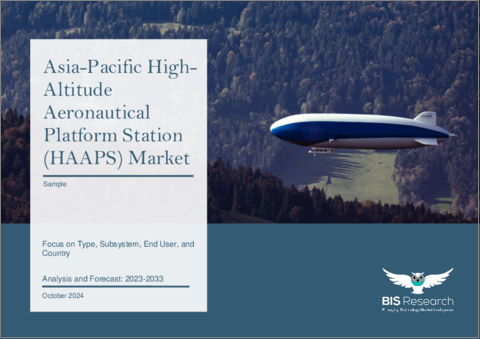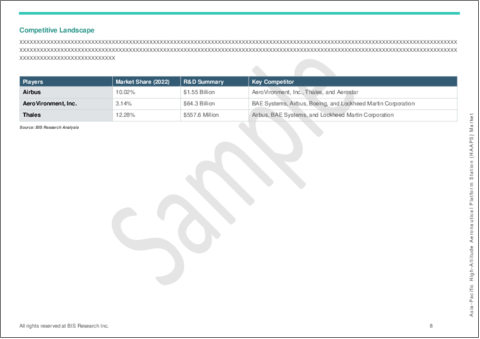|
|
市場調査レポート
商品コード
1585125
アジア太平洋の高高度航空プラットフォームステーション(HAAPS)市場:エンドユーザー別、タイプ別、サブシステム別、国別 - 分析と予測(2023年~2033年)Asia-Pacific High-Altitude Aeronautical Platform Station (HAAPS) Market: Focus on Type, Subsystem, End User, and Country - Analysis and Forecast, 2023-2033 |
||||||
カスタマイズ可能
|
|||||||
| アジア太平洋の高高度航空プラットフォームステーション(HAAPS)市場:エンドユーザー別、タイプ別、サブシステム別、国別 - 分析と予測(2023年~2033年) |
|
出版日: 2024年11月08日
発行: BIS Research
ページ情報: 英文 50 Pages
納期: 1~5営業日
|
全表示
- 概要
- 図表
- 目次
アジア太平洋の高高度航空プラットフォームステーション(HAAPS)の市場規模は、2023年の2億1,010万米ドルから2033年には5億5,590万米ドルに達し、予測期間の2023年~2033年のCAGRは10.22%になると予測されています。
高高度航空プラットフォームステーション(HAAPS)システムは、災害支援、環境監視、通信を含む様々な目的で大気衛星として運用されます。HAAPSは、高度18~22km(約59,000~72,000フィート)の成層圏で運用される自律艦隊システムであり、長期間のミッション用に構築されています。無人航空機システム(UAS)とは対照的に、その高高度能力は衛星と航空機の運用を強化します。アジア太平洋における安全で効率的な運用を保証するため、HAAPSは国内および国際的な空域規制を遵守しなければならず、その統合と配備を監督する特別な規制枠組みによって管理されています。HAAPSがさらに発展するにつれて、監視能力の向上、ネットワーク化の実現、アジア太平洋の災害対応活動の強化における重要性が増しています。
| 主要市場統計 | |
|---|---|
| 予測期間 | 2023年~2033年 |
| 2023年の評価 | 2億1,010万米ドル |
| 2033年の予測 | 5億5,590万米ドル |
| CAGR | 10.22% |
アジア太平洋の高高度航空プラットフォームステーション(HAAPS)市場は、高度な通信システムや環境モニタリングシステムに対するニーズの高まりにより拡大しています。通信、災害対応、環境モニタリングのカバレッジを向上させたHAAPSは、高度18~22kmの成層圏で運用することで、人工衛星に代わる特徴的な代替手段を提供します。HAAPSは、高度18~22kmの成層圏で運用されるため、衛星に代わる特徴的な代替手段となります。このプラットフォームは長時間空中に留まることができるため、軍事・民生両方の用途で非常に有用です。
HAAPSはアジア太平洋において、農村部での接続を強化し、気候モニタリングのような環境プロジェクトを支援するために不可欠な技術であると考えられています。自律システムの改善、経済的なエネルギー使用、国内外の機関による規制の後押しが、市場の主な促進要因となっています。APAC地域の企業や政府は、既存の衛星システムや地上システムを補完するためにHAAPS技術への投資を増やしており、その結果、市場全体の成長が促進され、さまざまな分野でその潜在能力が最大限に発揮されるようになっています。
当レポートでは、アジア太平洋の高高度航空プラットフォームステーション(HAAPS)市場について調査し、市場の概要とともに、エンドユーザー別、タイプ別、サブシステム別、地域別の動向、および市場に参入する企業のプロファイルなどを提供しています。
目次
エグゼクティブサマリー
第1章 市場
- 概要:高高度航空プラットフォームステーション(HAAPS)
- 比較分析:HAAPS対衛星システム対地上システム
- バリューチェーン分析
- 規制状況
- 主要な世界的出来事の影響分析-COVID-19
- プロジェクト
- 市場力学の概要
第2章 地域
- 地域別概要
- アジア太平洋
第3章 市場-競合ベンチマーキングと企業プロファイル
- 今後の見通し
- 地理的評価
第4章 調査手法
List of Figures
- Figure 1: Asia-Pacific High-Altitude Aeronautical Platform Station (HAAPS) Market (by Type), 2022, 2026, and 2033
- Figure 2: Asia-Pacific High-Altitude Aeronautical Platform Station (HAAPS) Market (by Subsystem), 2022, 2026, and 2033
- Figure 3: Asia-Pacific High-Altitude Aeronautical Platform Station (HAAPS) Market (by End User), 2022, 2026, and 2033
- Figure 4: Impact Analysis of Market Navigating Factors, 2023- 2033
- Figure 5: China High-Altitude Aeronautical Platform Station (HAAPS) Market, $Million, 2022-2033
- Figure 6: India High-Altitude Aeronautical Platform Station (HAAPS) Market, $Million, 2022-2033
- Figure 7: Australia High-Altitude Aeronautical Platform Station (HAAPS) Market, $Million, 2022-2033
- Figure 8: Rest-of-Asia-Pacific High-Altitude Aeronautical Platform Station (HAAPS) Market, $Million, 2022-2033
- Figure 9: Strategic Initiatives, 2020-2023
- Figure 10: Share of Strategic Initiatives, 2020-2023
- Figure 11: Data Triangulation
- Figure 12: Top-Down and Bottom-Up Approach
- Figure 13: Assumptions and Limitations
List of Tables
- Table 1: Market Snapshot
- Table 2: High-Altitude Aeronautical Platform Station Market, Opportunities across Regions
- Table 3: Comparative Analysis: HAAPS vs. Satellite Systems vs. Terrestrial Systems
- Table 4: Regulatory Landscape
- Table 5: Impact Analysis for Key Global Events - COVID-19
- Table 6: High-Altitude Aeronautical Platform Station (HAAPS) Market (by Region), $Million, 2022-2033
- Table 7: Asia-Pacific High-Altitude Aeronautical Platform Station (HAAPS) Market (by End User), $Million, 2022-2033
- Table 8: Asia-Pacific High-Altitude Aeronautical Platform Station (HAAPS) Market (by Type), $Million, 2022-2033
- Table 9: Asia-Pacific High-Altitude Aeronautical Platform Station (HAAPS) Market (by Subsystem), $Million, 2022-2033
- Table 10: China High-Altitude Aeronautical Platform Station (HAAPS) Market (by End User), $Million, 2022-2033
- Table 11: India High-Altitude Aeronautical Platform Station (HAAPS) Market (by End User), $Million, 2022-2033
- Table 12: Australia High-Altitude Aeronautical Platform Station (HAAPS) Market (by End User), $Million, 2022-2033
- Table 13: Rest-of-Asia-Pacific High-Altitude Aeronautical Platform Station (HAAPS) Market (by End User), $Million, 2022-2033
- Table 14: Market Share, 2022
Introduction to Asia-Pacific High-Altitude Aeronautical Platform Station (HAAPS) Market
The Asia-Pacific high-altitude aeronautical platform station (HAAPS) market is estimated to reach $555.9 million by 2033 from $210.1 million in 2023, growing at a CAGR of 10.22% during the forecast period 2023-2033. High-altitude aeronautical platform station (HAAPS) systems operate as atmospheric satellites for a variety of purposes, including disaster assistance, environmental monitoring, and telecommunications. HAAPS are autonomous fleet systems that operate in the stratosphere at altitudes of 18 to 22 kilometers (about 59,000 to 72,000 feet) and are built for long-duration missions. Their high-altitude capabilities, in contrast to unmanned aircraft systems (UAS), enhance satellite and aircraft operations. To guarantee safe and efficient operations in the Asia-Pacific (APAC) area, HAAPS must abide by national and international airspace regulations, which are governed by a special regulatory framework that supervises their integration and deployment. As HAAPS develops further, their importance in improving monitoring capabilities, enabling networking, and bolstering APAC disaster response operations grows.
Market Introduction
| KEY MARKET STATISTICS | |
|---|---|
| Forecast Period | 2023 - 2033 |
| 2023 Evaluation | $210.1 Million |
| 2033 Forecast | $555.9 Million |
| CAGR | 10.22% |
The Asia-Pacific (APAC) high-altitude aeronautical platform station (HAAPS) market is expanding due to the rising need for sophisticated communication and environmental monitoring systems. With improved coverage for telecommunications, disaster response, and environmental monitoring, HAAPS provide a distinctive substitute for satellites by operating in the stratosphere at altitudes ranging from 18 to 22 kilometers. Because these platforms can stay in the air for long stretches of time, they are very useful for both military and civilian uses.
HAAPS is seen as an essential technology in APAC for enhancing connection in rural locations and assisting with environmental projects like climate monitoring. Improvements in autonomous systems, economical energy use, and regulatory backing from national and international agencies are major market drivers. Businesses and governments in the APAC region are increasingly investing in HAAPS technology to complement existing satellite and terrestrial systems, thus fostering overall market growth and maximizing its potential across various sectors.
Market Segmentation:
Segmentation 1: by End User
- Commercial
- Government, Defense, and Research Institutes
Segmentation 2: by Type
- UAVs
- Airships
- Balloons
Segmentation 3: by Subsystem
- Flight Control Subsystem
- Energy Management Subsystem
- Communications Payload Subsystem
Segmentation 4: by Region
- China
- India
- Australia
- Rest-of-Asia-Pacific
How can this report add value to an organization?
Product/Innovation Strategy: The product segment helps the reader understand the different types of products available for deployment and their potential in APAC region. Moreover, the study provides the reader with a detailed understanding of the Asia-Pacific high-altitude aeronautical platform station (HAAPS) market based on applications on the basis of the end user (commercial and Government, Defense, and Research Institutes) and based on the products on the basis of type (UAVs, airships, balloons) and subsystems (flight control subsystem, energy management subsystem, and communications payload subsystem).
Growth/Marketing Strategy: The Asia-Pacific high-altitude aeronautical platform station (HAAPS) market has seen major development by key players operating in the market, such as business expansion, partnership, collaboration, and joint venture. The favored strategy for the companies has been partnerships and contracts to strengthen their position in the Asia-Pacific high-altitude aeronautical platform station (HAAPS) market.
Table of Contents
Executive Summary
Scope and Definition
1 Markets
- 1.1 Overview: High-Altitude Aeronautical Platform Station (HAAPS)
- 1.2 Comparative Analysis: HAAPS vs. Satellite Systems vs. Terrestrial Systems
- 1.3 Value Chain Analysis
- 1.4 Regulatory Landscape
- 1.5 Impact Analysis for Key Global Events - COVID-19
- 1.6 Projects
- 1.6.1 South Korea's Stratospheric Airship
- 1.7 Market Dynamics Overview
- 1.7.1 Market Drivers
- 1.7.1.1 Emergence of Artificial Intelligence
- 1.7.1.2 Increase in Use of Composite Material
- 1.7.1.3 Miniaturization of HAAPS Instruments and Payloads
- 1.7.2 Market Challenges
- 1.7.2.1 Technical Challenges such as Low Solar Panel Efficiency and Less Structural Integrity
- 1.7.3 Market Opportunities
- 1.7.3.1 Increase in Digitalization in Defense
- 1.7.1 Market Drivers
2 Regions
- 2.1 Regional Summary
- 2.2 Asia-Pacific
- 2.2.1 Regional Overview
- 2.2.2 Driving Factors for Market Growth
- 2.2.3 Factors Challenging the Market
- 2.2.4 Application
- 2.2.5 Product
- 2.2.6 China
- 2.2.7 India
- 2.2.8 Australia
- 2.2.9 Rest-of-Asia-Pacific
3 Markets - Competitive Benchmarking & Company Profiles
- 3.1 Next Frontiers
- 3.2 Geographic Assessment
4 Research Methodology
- 4.1 Data Sources
- 4.1.1 Primary Data Sources
- 4.1.2 Secondary Data Sources
- 4.1.3 Data Triangulation
- 4.2 Market Estimation and Forecast





